
The Biocide?
THE BIOCIDE is an inorganic Multi-Metal complex, that has unique water sanitation properties. It contains trace elements that control Algae, Waterborn diseases (Vibrio cholerae, yellow fever, ext.), Bacterial growth and Fungi and settles them out as harmless nutrients.
Independent testing on water revealed that THE BIOCIDE holds no danger to humans, plants or fish. This fact has been formally verified with daphnia waterflea mortality tests. The increased oxygen levels created by THE BIOCIDE treatment is actually beneficial to plant and aquatic life.
Within water there is a natural interaction between elements that takes place as can be seen on the chart below. Impurities in the water can prevent this interaction from taking place.
Mineral Interactions
P - Phosphorus Cr -
Chromium Co -
Cobalt Pb -
Lead Fe -
Iron Se -
Selenium Na -
Sodium Ca -
Calcium Ag -
Silver Cd -
Cadmium Hg -
Mercury Al -
Aluminum Cu -
Copper Mn -
Manganese K -
Potassium Mo -
Molybdenum I -
Iodine Mg -
Magnesium Zn -
Zinc SI - Silica As - Arsenic F -
Florine S - Sulfur

Direction of arrows denotes interference.
Arrows aimed at each other denote mineral synergy
Arrows aimed away from each other denote mutual mineral interference or antagonism.
THE BIOCIDE has the following active elements that help to activate these interaction between elements in the water and thus restore the water : Zinc nitrate, Copper nitrate, Potassium, Calcium, Sodium, Iron, Magnesium. These multi-elements act as anti-oxidants thus facilitating a multiplicity of reduction-oxidation reactions
THE BIOCIDE interacts with the impurities in water and either dissolves, flocculates or suspends the impurities, making it fit for industrial, recreational, and human usage.
THE BIOCIDE can remove chlorine, pesticides, organic matter, unpleasant tastes and odours, hydrogen sulphide, iron, lead, nickel, chromium, cadmium, calcium carbonate, aluminium, mercury, arsenic, and other organic compounds.
Other non-metal impurities react with THE BIOCIDE and form zinc oxides, copper hydroxides, hydroxides, and sulphates in the water. These by-products remain within the treated water, but are non-toxic. Also as part of this reaction, ozone is created and carried through into the treated water.
THE BIOCIDE has the ability to trigger and facilitate multi REDOX reactions. In so doing an environment within the water is created in which the water effectively "cures" itself. The water needs to be tested, to establish which trigger metals and trace elements are present.
The following laboratory test shows how the Biocide helps to balance the elements in a
Samples Received: Date of Analysis: Sample Container: Sample(name((
Determinate
Units
Detection Limits (DWAF
Copper
mg/l
<0.02
Zinc
mg/l
<0.01
Total nitrate
mg/l
<0.1
Model
Units
AMGB13AAT
6.3
1
4.6
TR
1.0
19
Watts | BTU/hr
3,500 | 12,113
Model
Units
Star Rating
Tonnage
TR
Cooling capacity
Watts | BTU/hr
water sample that was not at acceptable levels.
2. Applications
THE BIOCIDE has many applications for industrial as well as human usage:
- Drinking water sanitation
- Control and elimination of algae and fungi
- Sewage treatment
- Control and elimination of bacteria
- Malaria control
- Fly control
2.1 Drinking water sanitation
THE BIOCIDE offers a very simplistic solution to ensure clean drinking water to humans and animals.
Individuals can purify their own water by simply adding a drops of BIOCIDE to a litre of water. This will ensure clean and safe drinking water in even the most remote areas.
Treatment of waterworks with BIOCIDE ensures a trustworthy supply of drinking water.
Advantages of using BIOCIDE in drinking water systems:
- Natural minerals are restored.
- Elimination of harmful bacteria and e.coli in drinking water.
- Elimination of fungi and algae.
- Prevention of most water born diseases.
2.2 Control and eliminate Algae and Fungi
The alga Mycrocystis aeruginosa has become an international concern. This alga thrives on conditions where phosphates from the ever increasing agricultural activities in catchment areas, end up in water reservoirs and dams.
Mycrocyctis is toxic to humans and animals and causes diarrhoea, nausea and skin irritations.
In South Africa, the Hartebeespoort dam is badly infected causing major problems to residents, complaining of headaches and the unbearable stench from the algae. An area in the Hartebeespoort dam was isolated and treated. The results were monitored over a 72 hour period:
00 hours: Coagulation of Mycrocystis started immediately on contact.
24 hours: The coagulation process and killing of Mycrocystis on the surface was visible.
48 hours: The water showed a significant reduction on surface algae and the stench started to disappear.
72 hours: The water was almost clear and the stench completely disappeared.
Case Study 1: Hartebeespoort dam
Area 1: 0 Hours Area 1: 72 Hours

Untreated Treated
2.2.1 Isolated Sample Test
In support of the Hartebeespoort dam experiment, an individual coagulation test was run under controlled laboratory conditions. Fresh contaminated water samples (1.5 litre) were taken and left to stabilize. One sample was treated with THE BIOCIDE and monitored for 8 hours.
Results:
- Coagulation of sample started immediately.
- After one hour the dead algae started to sink to the bottom.
- The process of coagulation and killing algae continued at a steady pace for the next 7 hours.
- After 8 hours all the algae in the sample had sunk to the bottom and discoloration started.
Isolated Sample Test
0 Hour 1 Hour 8 Hour

Untreated Untreated Treated Untreated (Shaken) Treated Untreated
Case Study 2: Coffer dam

Before treatment
After treatment
Case Study 3 : Removing Algae from a Swimming Pool


Before treatment After treatment
2.3 Sewage Treatment
THE BIOCIDE has many applications for sewage treatment:
- Treatment of Waste Water Treatment Works (WWTW) effluent for faecal contamination with 100% disinfection efficiency.
- Treatment of French drains.
- Treatment of pit latrines.
- Treatment of bucket toilet systems, total decontamination, smell and odours disappear.
- Rural water and sewer treatment.
With the treatment of THE BIOCIDE, all WWTW effluents can meet the WHO guidelines for faecal contamination.
THE BIOCIDE is a chlorine-free, multi metal ligent that converts chlorine to chloride through REDOX reaction (latter is harmless).
Because THE BIOCIDE deactivates the chlorine indicator, you only have to measure for E. coli as per WHO guidelines or SANS 241 division 1 standard.
Case Study 4: Local Munisipality Sewage Plant
An accredited laborotory was approached by HydroCure to assist with THE BIOCIDE testing against a raw sewage sample from a Local Municipality.
Scope of the test method
Definitions:
THE BIOCIDE was measured against E.coli , faecal and total coliforms per 100ml. This method is used to determine the presence of faecal pollution in wastewater and ground water.
Faecal coliform group and E.coli are used as indicator organisms to test the effectiveness of effluent disinfection in a wastewater treatment plant.
Total coliforms: Gives an indication of the general sanitary quality of the water since this group includes bacteria of faecal origin mainly used in routine monitoring of water.
Faecal coliforms: Primarily used as a practical indicator of faecal pollution, it is more
used for assessments of faecal pollution of waste water, raw water supplies and natural water environments. (Rivers and Dams)
Escherichia coli: E.coli is a highly specific indicator of faecal pollution which originates from humans and warm blooded animals. E.coli is more often directly associated with faecal contamination and disease outbreaks in potable water than any of the other total or faecal coliforms .
Results
The tests were done in duplicates of two per concentration:
Sample 2A and 2B: 99ml raw sewage with 1ml BIOCIDE. Sample 4A and 4B: 990 ml raw sewage with 10ml BIOCIDE.
The results are counted in a 100ml Cfu
Time 0
30 minutes
60 minutes
120 minutes
Blank
E.coli
Total Conform
2 A
10000
10000
2 B
10000
10000
4 A
10000
10000
E.coli
Total Conform
E.coli
0
0
0
0
0
0
864
1000
0
Total Conform
E.coli
0
0
0
0
0
0
Total Conform
0
0
0
4 B
10000
10000
30
224
0
0
0
0
Sample 2A and 2B
Sample 4A and 4B


Case Study 5: Sewage overflow treatment

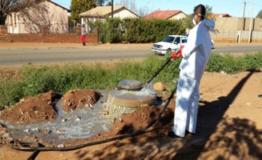
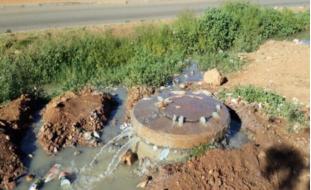
Treatment 10 Minutes after treatment

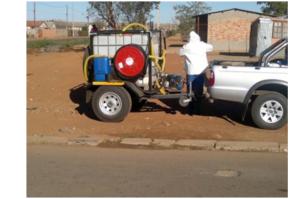
Kill percentage of Bacteria over 24 hours
Organism
1 Dt/l
10 Dt/l
P. putida
84.77
89.35
P. aeruginosa
27.98
100.00
P. stutzeri
73.47
98.91
40Dt/l
99.58
100.00
100.00
B. subtillis
58.32
88.88
100.00
B. licheniformis
84.73
91.55
B. megaterium
100.00
100.00
B.circulans
57.42
76.63
Micrococcus cristiae
59.48
72.01
97.79
100.00
92.05
79.48
Case Study 6: Game and Cattle waterhole
Case Study 7: Decontamination of pig farms
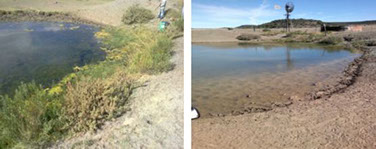

Before treatment After treatment
Before treatment After treatment
2.5 Malaria control
The biological control of malaria by breaking the life cycle of the mosquito is where THE BIOCIDE steps forward as the first line of defence.
When introduced into standing water, the breeding ground for mosquitoes, THE BIOCIDE disturbs the alkalinity of the first and second instar larvae, killing them in the process.
This makes the usage of substances like DDT, which is toxic for humans as well as animals, virtually redundant.
Dosage is via spraying THE BIOCIDE onto the water or even directly onto humans and animals

2.6 Fly control
THE BIOCIDE shows great effectiveness in fly control by killing larvae present in raw sewage and water, contaminated with organic matter.
THE BIOCIDE helps with the biological control of flies by breaking the life cycle of the fly. Dosage is via spraying of THE BIOCIDE onto the water.
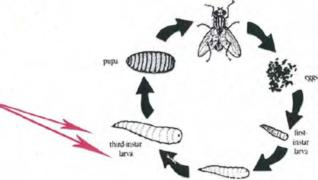
3. CSIR report on THE BIOCIDE
The River: River water in South Africa is often subject to faecal pollution and is the subject of controversy with regards to the effects of pollution on many individuals making use of the water for domestic purposes as well as for agricultural activities downstream.
THE BIOCIDE has been shown to treat drinking water to satisfy water quality guidelines. In South Africa, SANS 241 is the guideline used to ensure safe drinking water. Test results show that THE BIOCIDE adheres to these guidelines.
The pollution: The following micro-organisms have been found in a polluted river near Stellenbosch during a multiple year study in a local river: Streptococcus, Streptococcus faecalis, Enterobacter spp, Klebsiella spp, Citrobacter spp, Escherichia coli, Acinetobacter spp, Pseudomonas, Proteus mirabilis and Proteus vulgaris.
The treatment: Polluted river water was treated with THE BIOCIDE at low concentrations and tested for the SANS 241 drinking water quality specifications. The dosage was 20ul (2 drops) of THE BIOCIDE to a litre of water.
The result: After just 30 minutes the water met the SANS 241 specifications. See the table below
Sample
Total Bacterial count per ml
Total coliforms per 100ml
Raw river water
391
2420
10 minutes post treatment
240
25
20 minutes post treatment
22
4
E.coli per 100 ml
0
0
0
SANS 241 limit
100/ml
5/100m
0/100ml
There are various Biocides available for the treatment of water. Although these Biocides are often favoured, there are many negative aspects that are not always considered, such as:
- They often treat only part of the problem. They might for example reduce bacteria but not totally remove e-coli.
- They are more often than not harmfull to humans, such as chlorine.
- They do not have a wider application. Mosquitos will still breed in water treated with chlorine.
- the biocide brings a radically new dimension to providing useable water to people and places that were previously thought impossible.
THE BIOCIDE is, simply put, the future of water treatment.
ABOUT US
GET IN TOUCH
BLOO specializes in water Sanitation, Sewage and Effluent Treatment.
086 513 2606
296 Kent Avenue, Ferndale,
Randburg 2194
+27 11 781 4154
info@bloo.co.za
COPYRIGHT © 2015. Bloo
Disclaimer


